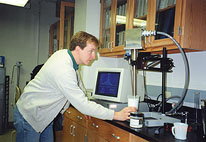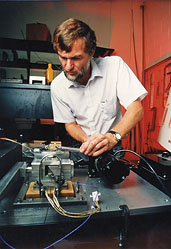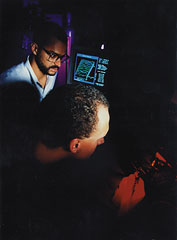

Center for Surface Engineering and Tribology (CSET)
Georgia Institute of Technology and Northwestern University
A National Science Foundation Industry/University Cooperative Research Center since 1985
An improved understanding of friction and wear leads to superior products and processes

|
Center Mission and Rationale
Failure resulting from the contact of solid surfaces is a critical problem that inhibits the development of key components in advanced engines, turbines, manufacturing processes, and magnetic recording systems. In order to develop advanced components for these applications, it is necessary to understand and control basic friction, wear, and lubrication processes at the sliding interface.
Surface engineering and tribology relates to the basic phenomena of contacting surfaces in relative motion. The broad mission of the Center for Surface Engineering and Tribology (CSET) is to marshal the resources and expertise of the two universities to advance new understanding and methods that will provide new tools for developing superior products and processes in the following industries:
- Heavy Machinery
- Automotive Products
- Railroads
- Lubricants
- Agricultural and Earth Moving Equipment
- Metal Processing
- Electronic and Data Processing
- Aerospace
- Chemicals
- Coatings

|
Research Program
The research program at Northwestern University (NU) encompasses
six areas:
- Gears' Bearings
- Seals
- Coatings
- Lubricant Fundamentals
- Engineered Surfaces
- Manufacturing Tribology
Recent Accomplishments
The Center at Northwestern University has recently developed the following new concepts, methods, models, materials, and software to predict and improve tribological performance and failure in machine components and metal forming processes:
- Analytical models and software to predict sliding wear and scuffing conditions in lubricated contacts based on new concepts in microelastohydrodynamic lubrication and surface film breakdown
- Software for lubrication and failure in spur gears, connecting rod bearings, piston ring, or skirt/liner contacts
- Analytical models for surface and subsurface contact fatigue life
- Efficient software to determine the subsurface residual stresses in Hertzian contacts
- Superhard carbon nitride coatings.

|
Special Activities
- Collaborating with Georgia Tech in investigations of chemical mechanical polishing.
The research program at the Georgia Institute of Technology (GIT) encompasses four areas:
- Seals and bearings
- Lubricant rheology
- Friction and wear in bearings
- Polishing and wear of silicon.
Recent Accomplishments
The Center at Georgia Institute of Technology has focused on expanding activities in the modeling of lip, face, and elastomeric seals; measurements of wear in hard disk drive surfaces; and manufacturing processing of semiconductors and ceramics. The following lists specific tasks conducted within CSET:

|
- A model of lip seals has been developed to include elastohydrodynamic and surface tension effects.
- A model of face seals has been developed to include transient effects.
- A simple analytical technique was developed to incorporate a realistic lubricant constitutive equation into an elastohydrodynamic inlet zone analysis, and the predictive technique has been successfully compared with experimental film thickness measurements on a non-Newtonian oil.
- Lubrication processes for hard disk drives have been studied.
- Chemo-mechanical polishing of silicon and sapphire is being related to hydrodynamic film thicknesses.
- Optimization of dicing of silicon has been studied.
Special Activities
- Two seals short courses are held annually to transfer technology to industry.
- A collaboration with the Center for Integrated Diagnostics has been established to study the precursors to mechanical seal failure.
Center Headquarters
Center for Surface Engineering and Tribology
George W. Woodruff School of Mechanical Engineering
Georgia Institute of Technology
813 Ferst Drive, MARC Suite 311
Atlanta, GA 30332-0405
Tel (404) 894-9100 * Fax (404) 894-3913
Co-Director: Dr. Steven Danyluk
steven.danyluk@me.gatech.edu
Co-Director: Dr. Leon Keer
(847) 491-4046 * l-keer@nwu.edu
Center Evaluator: Dr. Eliezer Geisler
(312) 906-6532 * geisler@stuart.iit.edu
NSF 01-168oo